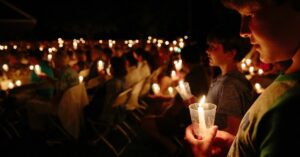
The last Easter Sunday Mass that St. Augustine celebrated was in 430 AD, when he was 75 years old. In those days, 75 was more like 100 is today. Augustine must have been very tired from having concluded the long Easter Vigil just a few hours before.
After his brief homily, the catechumens were dismissed and the doors closed. The elderly bishop moved slowly to the wooden altar in the center of the basilica and prayed the ancient prayer of thanksgiving. Then he asked the neophytes to gather close to him.
He pointed at what lay on the altar—some bread and a cup of wine, now changed into the Body and Blood of Christ. He said to the neophytes:
The mystery that you are lies there on the table.
Be what you see, and receive what you are. (Sermon 272)
Becoming the Mystery of Christ
For St. Augustine, the entire purpose of the catechumenate was to bring the seekers to this point. The point at which they would participate in the sacred mysteries and by doing so become, themselves, the Mystery of Christ.
For years, they had participated in the liturgy as catechumens. As their ancestors had done for centuries before them, they sang hymns, chants, and psalms during the first part of the liturgy. After they were baptized, they remained with the faithful to pray fervently for themselves and for all who were in need.
They prayed or sang the Creed and the Lord’s Prayer, which had been handed on to them during their catechumenate. They responded to the dialogue that began the great prayer of thanksgiving and sang their hosannas with the angels.
And most significantly, they approached the altar in faith and made a throne with their hands to receive the body of Christ. They bowed to the chalice and drank from the cup of salvation. Their amens rang out as a confession of belief in the mystery St. Augustine had taught them they now are.
The restoration of laity participation
That all changed shortly after Augustine died later that year. The world was changing, and in response, the church became more inwardly focused. The catechumenate died out, and the people became more and more passive in the celebration of the liturgy. Over the next 1,500 years, up until the mid-20th century, the participation of the faithful in the liturgy was almost completely suppressed.
The seeds of reform, however, began to be planted about 100 years before the Second Vatican Council.. The reform movement had grown to the point that every pope of the early twentieth century (Pius X, Benedict XV, Pius XI, Pius XII, John XXIII and Paul VI) made the restoration of the participation of the laity in the liturgy a central concern.
The Easter Vigil is the template for our liturgical participation in the Mystery of Christ. In some sense, we are not specifically preparing the catechumens to participate in the Sunday Eucharist. We are preparing them to celebrate the annual Pasch. The Sunday to Sunday Eucharist that we celebrate throughout the liturgical year is their (and our) ongoing preparation to celebrate the Great Vigil.
Why does the Easter Vigil start at night?
However, this understanding of the Vigil is relatively new for the modern church. As the catechumenate began to fade away after the 5th century, the full celebration of the Easter Vigil also faded. For centuries, the Easter Vigil was reduced to a brief Saturday morning rite presided over by the clergy with few of the faithful and no catechumens.
In the early 1950s, Pope Pius XII, responding to the liturgical movement to increase the participation of the baptized priesthood in the liturgy, initiated a reform of the liturgies of Holy Week. The way we celebrate Easter Vigil was central to the pope’s reform.
There are many elements to the restored Easter Vigil, but the most overarching is the restoration of the hour of celebration to after sunset. Why did the pope see this as so important for the participation of the baptized priesthood and eventually the catechumens? (Note that there were still no catechumens at the Vigil in the 1950s. That wouldn’t happen officially until the 1970s.)
Beginning the “mother of all vigils” in darkness would have needed no explanation to the people in St. Augustine’s time. But the meaning had been lost to us for so long that it is still today difficult to fully embody in our communities. In 1988, more than 30 years after the restoration of the Vigil to the dark of night, the Congregation for Divine Worship felt compelled to reemphasize the importance of celebrating the Vigil after the sun was well set.
“The entire celebration of the Easter Vigil takes place at night. It should not begin before nightfall; it should end before daybreak on Sunday” (Roman Missal, The Easter Vigil, n. 3). This rule is to be taken according to its strictest sense. Reprehensible are those abuses and practices which have crept in in many places in violation of this ruling, whereby the Easter Vigil is celebrated at the time of day that it is customary to celebrate anticipated Sunday Masses (Eucharisticum mysterium, [25 May 1967] n. 28).
Those reasons which have been advanced in some quarters for the anticipation of the Easter Vigil, such as lack of public order, are not put forward in connection with Christmas night, nor other gatherings of various kinds. (Circular Letter Concerning Preparation and Celebration of Easter Feasts, 78)
The Mystery we enter into
Our Easter Vigil is an echo of the Passover Vigil in which the ancient Hebrews kept watch for the Lord’s passing over, which freed them from slavery and death. In the same way, the Vigil we keep is our night of true liberation, in which “destroying the bonds of death, Christ rose as victor from the depths” (Roman Missal, The Easter Vigil, n. 19, Easter Proclamation).
From the earliest times of the church, centuries before St. Augustine, even, we have celebrated the annual Pasch, which is our most solemn and holy moment as the baptismal priesthood of Christ. This celebration is above all a night watch, during which we initiate the newest disciples into the paschal mystery of Christ. The neophytes rising out of the watery tomb foreshadow the coming Easter sunrise on the day of resurrection.
As St. Augustine said to his neophytes:
We keep vigil on that night because the Lord rose from the dead; that life… where there is no longer the sleep of death, began for us in his flesh; being thus risen, death will be no more nor have dominion… If we have kept vigil for the risen one, he will see that we shall reign with him for ever.” (Sermo Guelferbytan., 5, 4, PLS 2, 552)
This is the Mystery that we enter into in every Eucharist, and most fully and powerfully at the Easter Vigil. It is crucial that our catechumens/neophytes understand this. Not so much from our faltering explanations of the Mystery, but more so through keeping vigil with the entire church on the most solemn of nights.
This article is based on an article posted on Liturgy.Life.
Your turn
What aspect of the Easter Vigil is uniquely impactful for you? For your congregation? For your seekers and catechumens? Share your thoughts in the comments below.









The Easter Vigil brings us from l darkness into the light … the gospel readings during Lent show the power of Christ lovingly guides us to the sacraments that bring us grace and love. Through the gospel we also see the transformation we enter into … our opportunity to transform as we listen to the love and mercy of our generous God. Life will not be the same.
Thanks for sharing your thoughts Maria. I pray you and your community have a blessed Easter.